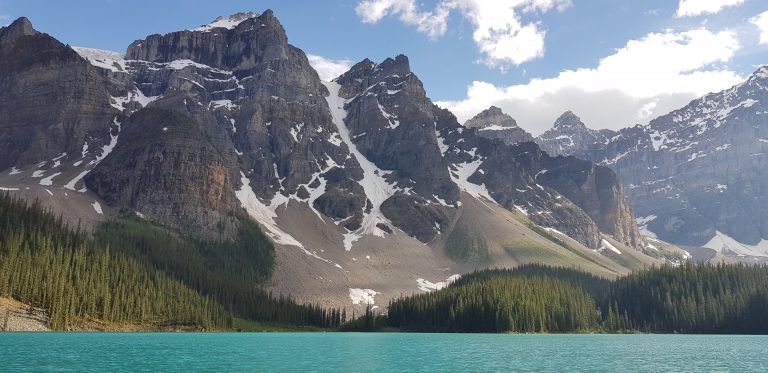
Glaciers of the Rockies are ‘isothermal’ – they are at the melting point throughout their depth. This means that free water and ice co‐exist englacially and subglacially throughout the year. Near the glacier surface, where the glacier is exposed to the atmosphere, winter cooling freezes the surface seasonally. Because seasonal snow insulates the glacier ice, the depth of the seasonal freezing layer is limited to the seasonal snowpack and the upper few metres of the glacier.
Prior to the onset of spring melt, the snowpack typically has a temperature of -5°C. During the spring thaw, percolation of meltwater into the snowpack and release of latent heat from refreezing rapidly restores snowpack temperatures to 0°C each April or May.
There is no simple ‘threshold temperature’ for a glacier to be viable. A mean annual temperature below 0°C is not a necessary or sufficient condition for glacier ice to exist. Tidewater glaciers in coastal B.C. and Alaska are vivid examples of this. Because ice flow delivers large fluxes of ice to low elevations, glaciers extend to sea‐level environments where mean annual temperatures are several degrees above 0C. This is intrinsic to all glaciers; glacier ice in the ablation area does not grow in situ, but is a consequence of ice transport from the accumulation area to the ablation area.
The mean annual temperature at the terminus of the Haig Glacier (2,460 m elevation), the only glacier site in the Rockies where detailed data is available, is approximately -2.1°C (2001‐2009). The head of the glacier (2,735 m on the continental divide) had a mean temperature of -3.9°C over this period.
There is cooling with latitude in the Canadian Rockies, leading to a general pattern of lower elevations for glacier termini in central and northern Alberta. Environment Canada’s Sunwapta station on the Icefields Parkway (1,555 m) is no longer active, but from 1979‐2000 it recorded a mean annual temperature of -0.3°C. This is the most proximal data to the Columbia Icefield, the most glaciated region of Alberta.
Terminus elevations of the Columbia’s major outlets (e.g., Saskatchewan, Athabasca) are 2,100 m; given typical surface‐temperature lapse rates of -5.5°C/km in the Rockies, mean annual temperatures for these outlet glaciers will be close to -3°C. These glaciers descend to lower elevations than those in Kananaskis Country because they are fed by large fluxes of ice from the interior accumulation region of the Columbia Icefield. At the elevation of the Columbia Icefield accumulation area, above 2,800 m, mean annual temperatures are estimated to be below -6°C.
We provide Canadian educational resources on water practices to promote conservation and sustainability. Our team crafts current and relevant content, while encouraging feedback and engagement.
The Canada WaterPortal is a registered charity, #807121876RR0001
We recognize and respect the sovereignty of the Indigenous Peoples and communities on whose land our work takes place.
© 2025 All Rights Reserved.